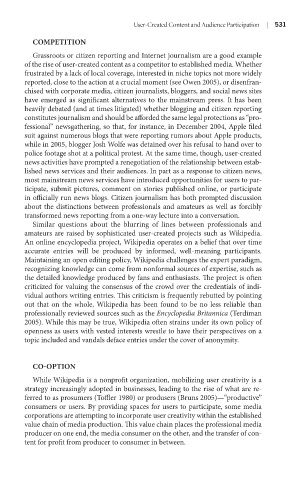Page 552 - Battleground The Media Volume 1 and 2
P. 552
User-Created Content and Aud ence Part c pat on | 1
ComPETiTion
Grassroots or citizen reporting and Internet journalism are a good example
of the rise of user-created content as a competitor to established media. Whether
frustrated by a lack of local coverage, interested in niche topics not more widely
reported, close to the action at a crucial moment (see Owen 2005), or disenfran-
chised with corporate media, citizen journalists, bloggers, and social news sites
have emerged as significant alternatives to the mainstream press. It has been
heavily debated (and at times litigated) whether blogging and citizen reporting
constitutes journalism and should be afforded the same legal protections as “pro-
fessional” newsgathering, so that, for instance, in December 2004, Apple filed
suit against numerous blogs that were reporting rumors about Apple products,
while in 2005, blogger Josh Wolfe was detained over his refusal to hand over to
police footage shot at a political protest. At the same time, though, user-created
news activities have prompted a renegotiation of the relationship between estab-
lished news services and their audiences. In part as a response to citizen news,
most mainstream news services have introduced opportunities for users to par-
ticipate, submit pictures, comment on stories published online, or participate
in officially run news blogs. Citizen journalism has both prompted discussion
about the distinctions between professionals and amateurs as well as forcibly
transformed news reporting from a one-way lecture into a conversation.
Similar questions about the blurring of lines between professionals and
amateurs are raised by sophisticated user-created projects such as Wikipedia.
An online encyclopedia project, Wikipedia operates on a belief that over time
accurate entries will be produced by informed, well-meaning participants.
Maintaining an open editing policy, Wikipedia challenges the expert paradigm,
recognizing knowledge can come from nonformal sources of expertise, such as
the detailed knowledge produced by fans and enthusiasts. The project is often
criticized for valuing the consensus of the crowd over the credentials of indi-
vidual authors writing entries. This criticism is frequently rebutted by pointing
out that on the whole, Wikipedia has been found to be no less reliable than
professionally reviewed sources such as the Encyclopedia Britannica (Terdiman
2005). While this may be true, Wikipedia often strains under its own policy of
openness as users with vested interests wrestle to have their perspectives on a
topic included and vandals deface entries under the cover of anonymity.
Co-oPTion
While Wikipedia is a nonprofit organization, mobilizing user creativity is a
strategy increasingly adopted in businesses, leading to the rise of what are re-
ferred to as prosumers (Toffler 1980) or produsers (Bruns 2005)—“productive”
consumers or users. By providing spaces for users to participate, some media
corporations are attempting to incorporate user creativity within the established
value chain of media production. This value chain places the professional media
producer on one end, the media consumer on the other, and the transfer of con-
tent for profit from producer to consumer in between.

